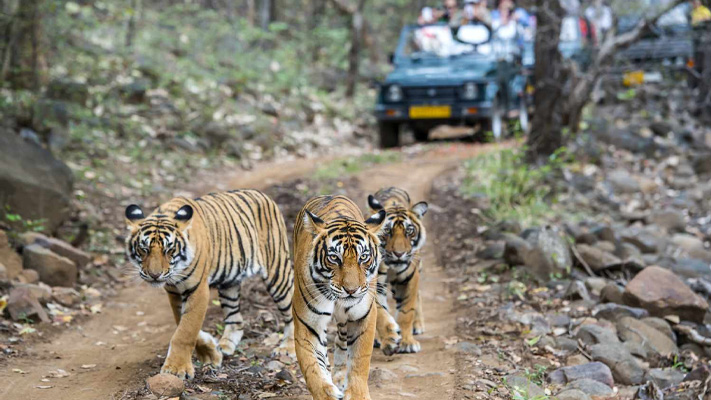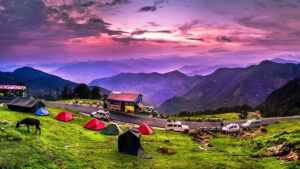RANTHAMBORE NATIONAL PARK, RAJASTHAN – DISCOVER THE LAND WHERE TIGERS ROAM FREE

Nestled amidst the rugged landscapes of Rajasthan, India, Ranthambore National Park emerges as a captivating destination that seamlessly blends wildlife encounters with a rich historical legacy. Spanning across sprawling expanses, this renowned wildlife sanctuary is famed for its majestic Bengal tigers, which roam freely amidst the remnants of the ancient Ranthambore Fort. As visitors venture into the heart of the park, they are greeted by a tapestry of diverse wildlife, including leopards, deer, crocodiles, and an array of avian species. Beyond its wildlife riches, Ranthambore’s allure lies in its ability to transport travelers through time, offering glimpses into the region’s royal past. From exhilarating safaris to the mesmerizing ruins, Ranthambore National Park beckons nature enthusiasts and history lovers alike, promising an unforgettable journey into the wild heart of Rajasthan.

What to Expect
When visiting Ranthambore National Park, there are several things you can expect to enhance your experience:
- Wildlife Sightings: Ranthambore is renowned for its population of Bengal tigers, and while spotting them is never guaranteed, the park offers a good chance of seeing these majestic creatures in their natural habitat. Keep in mind that wildlife sightings are dependent on various factors, including luck, timing, and the expertise of your guide.
- Thrilling Safaris: Embark on exhilarating jeep or canter safaris through the park’s diverse terrain. Led by experienced guides, these safaris take you deep into the wilderness, providing opportunities to spot a wide range of wildlife, from leopards and deer to crocodiles and various bird species.
- Varied Landscapes: Ranthambore National Park showcases a blend of diverse landscapes, including dry deciduous forests, open grasslands, and picturesque lakes. The ever-changing scenery adds to the allure of the park and offers a stunning backdrop for wildlife encounters.
- Ranthambore Fort: Explore the magnificent Ranthambore Fort, a historic marvel that stands as a testament to the region’s rich heritage. Perched atop a hill, the fort offers panoramic views of the park and its surroundings, along with fascinating insights into Rajasthan’s royal past.
- Birdwatching Opportunities: Ranthambore is a paradise for bird enthusiasts, with over 270 bird species recorded within the park. From vibrant kingfishers and eagles to migratory birds, the diverse avian population ensures rewarding birdwatching experiences.
- Conservation Efforts: Ranthambore National Park plays a crucial role in tiger conservation in India. By visiting the park, you contribute to ongoing conservation efforts and support the protection of these endangered species and their habitats.
As with any wildlife destination, it’s important to approach your visit with realistic expectations. While Ranthambore offers incredible wildlife experiences, the sightings can be unpredictable.
Top Attractions
Ranthambore National Park and its surrounding areas offer a range of attractions that complement the wildlife experience and provide glimpses into the region’s rich cultural and historical heritage. Here are some of the top attractions to explore:

- Ranthambore Fort: Standing tall within the national park, the magnificent Ranthambore Fort is a UNESCO World Heritage Site. Built in the 10th century, this historic fortress offers panoramic views of the surrounding landscapes and houses ancient temples, palaces, and step wells. Exploring the fort provides a fascinating glimpse into Rajasthan’s royal history.
- Trinetra Ganesh Temple: Located within the Ranthambore Fort complex, the Trinetra Ganesh Temple is a revered Hindu shrine dedicated to Lord Ganesha. It attracts devotees from far and wide who come to seek blessings and offer prayers. The temple is known for its unique idol of Lord Ganesha with three eyes.
- Surwal Lake: Situated close to Ranthambore National Park, Surwal Lake is a picturesque water body that attracts a variety of bird species. It is a popular spot for birdwatching, especially during the winter months when migratory birds flock to the lake. The serene surroundings make it a tranquil place to unwind and enjoy nature.
- Kachida Valley: Located on the outskirts of Ranthambore, Kachida Valley is a scenic area known for its rocky terrain and lush vegetation. It provides a beautiful backdrop for wildlife sightings and offers opportunities for nature walks and photography.
- Rajiv Gandhi Regional Museum of Natural History: Situated near the park’s entrance, this museum provides insight into the flora, fauna, and geology of the region. It features informative exhibits, interactive displays, and audio-visual presentations that educate visitors about the biodiversity of Ranthambore and its surroundings.
- Padam Talao: One of the largest lakes within Ranthambore National Park, Padam Talao is not only a scenic water body but also a prime location for wildlife spotting. It is known for its resident crocodile population and offers opportunities to observe birds and other wildlife in their natural habitat.
- Sawai Mansingh Sanctuary: Located adjacent to Ranthambore National Park, this sanctuary is known for its diverse flora and fauna. It provides an alternative wildlife experience and is home to species such as leopards, hyenas, wild boars, and various bird species.
Best Time to Visit
The best time to visit Ranthambore National Park is during the dry season, which spans from October to April. Here’s a breakdown of the seasons and what to expect during each:

- Winter (October to February): This is considered the peak season for wildlife sightings in Ranthambore. The weather is pleasant, with cool mornings and evenings and moderate daytime temperatures. Wildlife is more active during this time, including the elusive Bengal tigers. It’s advisable to carry warm clothing for early morning and evening safaris.
- Spring (March to April): The spring season in Ranthambore is characterized by gradually rising temperatures. It’s a good time for wildlife sightings, and the park’s vegetation starts to turn lush and green. The landscapes are picturesque, and birdwatching enthusiasts can enjoy spotting migratory birds before they begin their journey back.
- Summer (May to June): The summer months in Ranthambore can be quite hot, with temperatures soaring during the day. However, it is during this time that the wildlife sightings, especially of tigers, are at their best. Animals gather around water sources, providing excellent opportunities for sightings and photography. The park remains open until the end of June before closing for the monsoon season.
- Monsoon (July to September): Ranthambore National Park is closed for visitors during the monsoon season due to heavy rainfall. The park undergoes rejuvenation during this time, with lush vegetation and replenished water bodies. However, access to the park is restricted, and wildlife sightings are unlikely.
It’s important to note that the weather patterns can vary, and temperatures can be extreme, especially during summer months. It’s advisable to check the current weather conditions and plan your visit accordingly. Additionally, it’s recommended to book safari permits and accommodations well in advance, especially during the peak season, to secure your preferred dates.

Safaris at Ranthambore National Park
Safaris at Ranthambore National Park provide an exhilarating opportunity to explore the wilderness and encounter the incredible wildlife that calls the park home. Here are some key points about the safaris:
- Jeep Safaris: Jeep safaris are a popular choice for wildlife enthusiasts visiting Ranthambore. These open-top 4×4 vehicles offer a thrilling and up-close experience of the park’s diverse flora and fauna. Each jeep can accommodate up to six passengers along with an experienced guide who helps spot wildlife and provides insights into the park’s ecosystem.
- Canter Safaris: Canters are large open-top vehicles that can accommodate a larger number of people, typically 20 passengers. Canter safaris are an excellent option for larger groups or those who prefer a shared experience. Like jeep safaris, canter safaris are led by experienced guides who navigate through the park and provide information about the wildlife and surroundings.
- Zones and Routes: Ranthambore National Park is divided into several zones, each with its unique characteristics and wildlife sightings. The park authorities allocate specific zones to safari vehicles to manage the tourist flow and minimize disturbance to the animals. The zones are allocated randomly, and visitors have an equal chance of exploring different areas of the park.
- Morning and Afternoon Safaris: Safaris at Ranthambore National Park are conducted in two sessions – morning and afternoon. The morning safari usually starts before sunrise, allowing visitors to witness the awakening of the park and the possibility of spotting wildlife in their active state. The afternoon safari takes place in the latter half of the day, providing a chance to observe animals during their feeding or hunting activities.
- Duration and Permits: A typical safari at Ranthambore lasts for about three to four hours, including the travel time within the park. To participate in a safari, visitors need to obtain permits from the park authorities. It is advisable to book safari permits in advance, especially during the peak season, as the number of vehicles allowed into the park is limited.
- Professional Guides: Every safari vehicle at Ranthambore National Park is accompanied by a trained naturalist or guide who is well-versed in the park’s flora, fauna, and conservation efforts. These guides play a crucial role in spotting wildlife, sharing insights, and ensuring a safe and informative safari experience.


















































